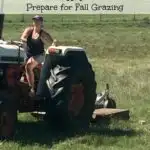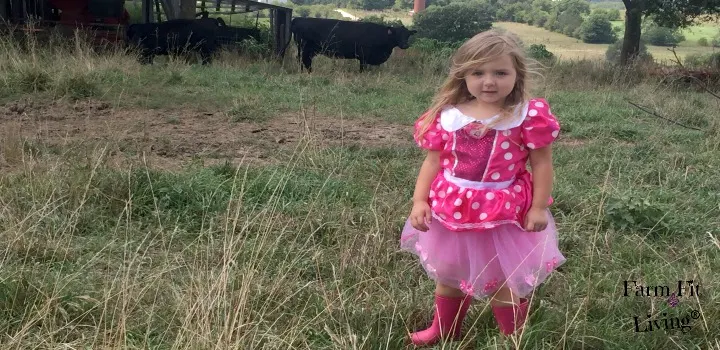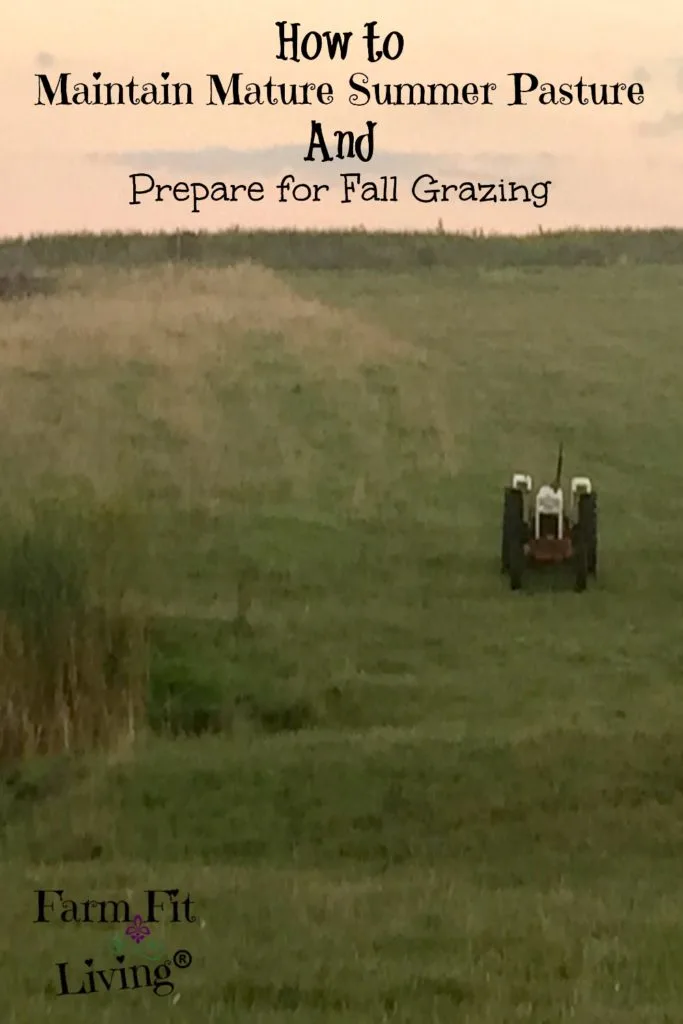If you want to make the most of pasture grasses, maintain mature summer pasture.
Maintain mature summer pasture at the end of the summer grazing season to maximize quality and nutrition of the vegetation your livestock needs.
Because grass fed livestock is all the rage. It’s what many consumers want these days. People will pay a premium to have grass fed meat or milk for their families. So, if you’re chasing that market, you’re going to have to protect and promote good quality growth of your grasses.
Pasture grazing livestock is also the most economical in your livestock operation. There’s no better way to save time and money by releasing your livestock out into a pasture to graze for months.
But, there’s an art to grazing that many people and new livestock owners may not realize. Pastures take a lot of work to be maintained and at best quality each year. Grasses and other vegetation aren’t there to just be in a natural state all year round.
The most sustainable pastures have some proper maintenance schedules. Take the time each year to observe your pastures and grasses in your own area. And as summer vegetation nutrition quality fades away into the abyss, here are a few tips for maintaining your pastures to ensure the best quality.
Proper Pasture Care
A few necessary proper pasture care items for your to-do list would be these:
- Complete a quick overview of your pasture.
- Move livestock to another new pasture with plenty of vegetation.
- Decide if there are any poor spots in the old pasture where grass did not grow as well.
- Take some soil samples to determine fertility rates.
- Mow back mature summer grasses to promote new fall grass growth.
- Re-Seed grasses in late August-mid September using high quality seed.
This checklist not only assists in sustaining the quality of your pasture, but it is great for promoting new regrowth for fall grasses. Promoting new regrowth should be your ultimate goal if you’re wanting to extend your grazing season into the fall.
To ensure a strong fall grazing season, you have to maintain mature summer pasture. You have to cut back the old to make room for new growth. One of the ways we maintain summer pasture near the end of summer is by mowing.
Mow Summer Pastures
There’s no question about it. If you watch livestock graze, you’ll see what they prefer. They want fresh, new grass regrowth. Not old, mature grasses with a seed head. Old weeds that have reached their prime will not even appeal to sheep. They want the new stuff.
All livestock want to graze closer to the ground. They want to eat what’s new and upcoming first, which isn’t always a good thing.
Also, grazing animals don’t want old rag weed. They don’t want tall thistles or little trees with no leaves. And these awful annoying old weeds and trees steal nutrients from the little yummy fall grasses trying to emerge.
We promote fall grass growth by getting rid of weeds and unwanted trees. One of the ways we can achieve this is by mowing. We use a rotary mower hooked to a tractor and mow about 6-8 inches high. And we mow everything and everywhere we can.
No, this height doesn’t nap any of the new fall grasses coming up. But it does trim off old mature grasses, which is our main goal. Plus, it kills weeds and trees stealing the good stuff from the ground.
And mowing also helps with the competition by making the entire pasture vegetation all one length. Vegetation all one length will help to promote proper growth of good grasses.
Keep in mind – You shouldn’t mow your pastures through the summer more than three or four times. And we prefer to just mow once at the end of the season, since we multispecies graze sheep, cattle and goats.
Finally, mowing helps you to get that overview of what kind of vegetation you have in your pasture.
Get An Overview of Pasture Vegetation
It’s always best to know what you have out there. Know what you have so you can make the most of the grazing season. Keep vegetation that animals like and gain weight on. Get rid of things they don’t do well on.
Also, what grasses are not growing well? Or what vegetation is best for growth in the late summer for fall grazing? What areas of your pasture are lacking in growth? Where are your poor spots that need some work?
Furthermore, it’s important to note the different nutrient and vegetation requirements of each species of livestock you’re grazing. For example, goats are known to be browsers. This means, they prefer to eat up off the ground – tree leaves, weeds, taller grasses, etc.
But, I have found that goats excel on mowed and regrown fall pastures. And this is important since most of my does are heavy pregnant well into the fall months.
Then, sheep prefer weeds and grasses. And cattle, as we all know, are grazers who prefer lush grasses. So, plan according to the needs of your livestock as to how you should change or improve the content of your fall pastures.
After mowing pastures, it’s time to figure out how you can make your pasture better. How you can feed the soil the proper nutrients to grow nutritious vegetation. And what seeds will do the best in your area and under average growing seasons.
Fertilize & Re-Seed Grasses
After mowing, it’s easy to tell where the poor spots in the pasture really are. But you really don’t know what nutrients the spot is lacking until you complete a soil test.
So, take that soil test using a soil probe. Then, feed your soil the appropriate nutrients needed to help proper vegetation thrive.
Choose grass seed native to the area and the time of application. If you can, sow the seed before a chance of rain for best results. Because we all know that the proper recipe for vegetation growth from seed is soil, sunlight and water.
One thing I don’t recommend is planting tree seedlings or weed seed for goats and sheep. Because they are going to come up naturally as they are naturally spread by birds and other wildlife. You are going to have enough of those invasive vegetation. There’s no need to further the problem by planting more. And the sheep and goats are only going to eat what they want to eat while unwanted vegetation takes over.
Finally, work with Mother Nature. Use active rainfall chances to your advantage by sowing seeds just before that next rainfall. And give the seeds time to germinate and emerge before letting the livestock onto it. This is also known as resting the pasture.
Rest the Pasture
After working the pasture over and reseeding, it’s time to let the pasture rest for a while. Give the pasture at least one month before allowing livestock to start grazing. So, usually around mid-October to early November, the pasture will be good to go for fall grazing. This highly depends on your location and the weather – When the first snow flies.
You should always have extra late summer pasture available while your fall pasture is resting. This could be pasture that has been mowed previously, such as a hay field that has some regrowth. This is also a great way to naturally fertilize the pasture while the newly maintained pasture rests.
More about grazing brome or grass hay fields: It’s a great sanctuary for livestock while you maintain mature summer pasture and prepare for fall grazing. Plus, hay fields usually have areas around the field with trees and brush that are perfect for goat browsing.
Another alternative grazing option while you maintain mature summer pasture for fall grazing is to let livestock graze crop waterways or harvested crop fields. If proper fencing and water source is superb, livestock can meet nutritional requirements while waiting for you to maintain mature summer pasture.
So, resting the summer pasture for later fall grazing is not only necessary for new seedlings. But for established and new regrowth as well. So, resting the pasture plays a major role when you learn to maintain mature summer pasture.
Limitations
Extending the grazing season of a pasture that has been grazed throughout the summer has extreme limitations. You should know them and follow them in order to protect your pastures from overgrazing and long-term damage.
First of all, if grasses are not regrowing, the pasture should not be grazed through the fall. There are a number of reasons why grasses do not regrow after they’ve been grazed or mowed.
One major reason for lack of regrowth is due to the lack of rainfall. If your area lacks the rainfall grasses need to regrow, you really should keep livestock off the pastures.
Another limitation is the quality of vegetation. Are your fall grasses growing in green and lush? Or is there something causing vegetation to be lower quality? This problem can be solved by means of a soil test. However, it would be best to keep livestock off until a questionable problem is solved. Or supplement with minerals and nutrients.
Next, fencing can be a problem in the fall. Especially with crops on the other side. Build and maintain high quality fencing so livestock aren’t tempted to escape to the corn field on the other side.
Finally, are noxious weeds coming up in your fall pastures? Or is it riddled with parasite loads? This is a very controllable limitation that just takes time and work. Mowing pastures can really help with weed control. And multispecies grazing of sheep, goats, and cattle can really help with fall parasite loads.
And if the fall pasture just is not providing the nutrients to meet your livestock needs, you may want to consider supplementing.
Supplementing
Livestock needs are simple. They need protein and trace minerals in their diets to thrive and survive. Just like us.
And also just like us, they can’t always get all of their nutrients from what is provided to them. Therefore, they need to be supplemented when their energy needs require more.
This is true if you are grazing pregnant livestock in the fall if the vegetation is low quality. To be safe, always provide a high-quality loose mineral and clean water free choice to all grazing livestock.
For pregnant and lactating livestock, we also provide free-choice protein tubs to help meet their protein and energy requirements. It takes a ton of energy and work on their part to grow and feed babies.
But it’s always best to be the proactive livestock producer you are and provide what’s best for you livestock. This starts with learning to maintain mature summer pasture and providing the best quality nutrients throughout the fall months.
Maintain Mature Summer Pasture
Because it’s what you need to do to sustain your livestock’s grazing season. To remain the producer who raises grass-fed livestock to promote a healthy, quality and inexpensive product.
The secret to sustainability in the grass fed world is to understand, work and maintain pasture. It does take time and effort to provide quality vegetation for your grazing livestock.
You have to know what you have out there in your pastures. You still need to know what your livestock is eating and what they NEED to eat to produce for you. Livestock production at any level is not sustainable unless the livestock is being fed proper nutrition to meet energy levels.
So, know what you have with an overview after you maintain mature summer pasture by mowing. Make a plan according to that overview. This plan could include soil testing, fertilizing and re-seeding. Then, let your pasture rest for ample amount of time.
Monitor the pasture before putting livestock back out there. Know what limitations could occur and be prepared. Always have extra pasture or hay available in case of a natural Mother Nature disaster you can’t control.
Finally, I can’t stress enough to know what your livestock needs are. The end of the natural grazing season is only the beginning. So, maintain mature summer pasture to extend that grazing season well into the fall to help livestock meet their optimum nutritional needs.
~ Much Love ~








Winter Goat Care Guide for a Healthy Herd | Farm Fit Living
Monday 23rd of October 2017
[…] finding a way to get through the winter leads to healthy goats and deeper pockets preparing for the grazing season. It takes preparation, planning and lots of watching. So, get out there, implement some new proven […]
Spring Pasture Management Tips for Grazing Cattle | Farm Fit Living
Friday 7th of April 2017
[…] Read about pasture management tips for FALL grazing here […]
Taylor Smith
Monday 19th of September 2016
Very cool! I am not a farmer but appreciate that you are!
Sarah Kuziomko
Wednesday 24th of August 2016
I still live in an apartment but really hope to have a little farm someday. When I do I know where I am going to go to get some tips!
Sarah Kuziomko
Wednesday 24th of August 2016
I still live in an apartment but really hope to have a little farm someday. When I do I know where I am going to go to get some tips!